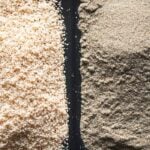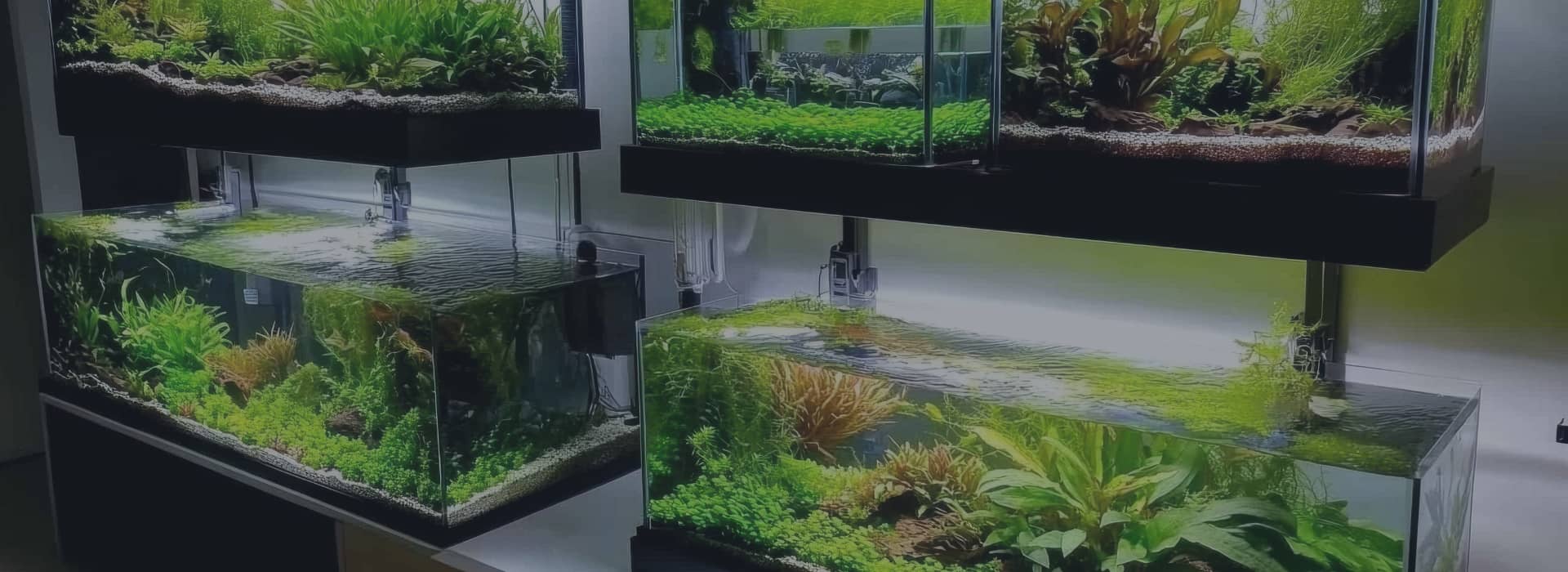When choosing an aquarium, one of the most significant decisions you’ll face is whether to go for a glass or acrylic tank. Glass and acrylic are the two primary materials used for aquarium construction, and each has its unique characteristics and advantages. Understanding the differences between these two options is crucial in determining which one is better suited for your specific needs and preferences.
This guide will explore the pros and cons of glass and acrylic aquariums, helping you make an informed decision. We will delve into factors such as durability, clarity, weight, cost, and customisation options to assess which material aligns better with your aquarium goals.
Construction and Material Properties:
Let’s compare them in terms of construction and material properties.
Construction:
- Glass aquariums are typically constructed using sheets of tempered or annealed glass that are bonded together using a silicone sealant. The glass panels are usually thicker and heavier compared to acrylic, which affects the overall weight of the aquarium.Acrylic aquariums are made from sheets of acrylic, which are joined together using a solvent or adhesive. The panels of acrylic aquariums can be thinner than glass, allowing for more flexibility in design and shaping.
Material Properties:
- Strength: Glass is generally stronger and more rigid than acrylic. It is less prone to scratches and scuffs, making it a durable choice for long-term use. Acrylic is less rigid and more susceptible to scratching, but has higher impact resistance and is less likely to shatter.
- Weight: Glass aquariums are heavier than acrylic ones of similar dimensions. This can make glass aquariums more challenging to move or transport. They also require sturdier stands.
- Design flexibility: Acrylic is a more versatile material in terms of shaping and design possibilities. It can be easily moulded into curved or custom shapes, giving aquarists more options for unique aquarium designs. Glass, on the other hand, is limited to straight and flat panel configurations.
- Insulation: Acrylic provides better insulation properties compared to glass, resulting in less heat transfer between the water and the surrounding environment. This insulation can help maintain more stable water temperatures in the aquarium.
Both glass and acrylic aquariums have their own set of advantages and considerations. Glass offers superior strength, durability, and long-term clarity. Acrylic, on the other hand, provides greater design flexibility, impact resistance, and insulation properties. The choice between the two materials often depends on personal preferences, budget, desired design, and the specific needs of the aquarist.
Clarity and Transparency:
Clarity and transparency in aquarium building materials might seem like the same thing, but they aren’t. Clarity refers to how visible and distortion-free the interiors of the aquarium are. Transparency refers to how much light is absorbed by the material itself. There are some key differences to consider when comparing glass and acrylic aquariums based on clarity and transparency.
- Clarity: Glass aquariums tend to provide superior clarity compared to acrylic aquariums. Glass allows light to pass through with minimal distortion. This results in a clearer and sharper view of the aquarium inhabitants and décor. Acrylic, on the other hand, may have slight variations in clarity, and over time, it can develop small scratches that can affect visibility. Acrylic can also take on a yellowish tinge over time.
- Transparency: Acrylic aquariums generally offer better transparency than glass aquariums. Acrylic has a higher light transmittance, meaning it allows more light to pass through (up to 92%), resulting in brighter and more vibrant colours in the aquarium. Glass tends to absorb more light (transparency of about 80%), reducing the overall brightness and potentially dulling the colours.
Weight and Handling:
When it comes to comparing glass and acrylic aquariums based on weight and handling, there are some notable differences to consider:
- Weight: Glass aquariums tend to be heavier than acrylic ones. Glass is denser and more substantial, which means that larger glass tanks can become extremely heavy. Acrylic, on the other hand, is much lighter and offers a significant advantage for people who want to set up larger aquariums without the concern of excessive weight.
- Fragility: Glass aquariums are more prone to breaking than acrylic ones. Glass can shatter if subjected to a strong impact or if dropped, which makes it a bit more delicate to handle. Acrylic, although less rigid than glass, is much more durable and resistant to cracking or breaking. It can withstand accidental impacts better, making it safer, especially for households with children or pets.
- Handling and Installation: Due to their weight, glass aquariums require more caution and effort when handling and installing them. It may be necessary to have multiple people or special equipment to safely move and position a heavy glass tank. Acrylic aquariums, being lighter, are generally easier to handle and manoeuvre. One or two people can move and install them with relative ease.
- Shape and Customisation: Acrylic is more flexible than glass, allowing for greater design possibilities. Acrylic aquariums can be moulded into various shapes, including curved or rounded corners, offering a sleek and modern appearance. Glass tanks, while typically rectangular, are limited in terms of customisation options.
If weight and ease of handling are important factors for you, acrylic aquariums are a preferable choice. They are lighter, more durable, and easier to manoeuvre compared to glass aquariums. However, a glass aquarium can still be an excellent option if you prioritise a traditional rectangular shape and don’t mind the added weight.
Customisation and Design:
Let’s look at both these materials based on how customisable they are.
- Shape and Size: Glass aquariums are typically limited to rectangular or square shapes due to the nature of the material. On the other hand, acrylic is highly malleable and can be easily shaped into various forms, including curved, bow-front, cylindrical, hexagonal, or even more intricate designs. Acrylic offers more flexibility when it comes to creating unique aquarium shapes and sizes.
- Weight and Support: Glass aquariums tend to be heavier than acrylic tanks, especially when considering larger sizes. The weight of glass may necessitate the use of sturdier stands or additional structural support. The lighter acrylic allows for more versatile placement options and may require less robust support structures.
- Customisation Options: Acrylic offers greater customisation options compared to glass. It can be easily drilled, cut, and bonded, allowing for the addition of various accessories like overflow systems, built-in sumps, or intricate plumbing arrangements. Glass tanks, while still customizable to a certain extent, generally require more specialised tools and expertise for modification.
- Visual Appeal: Both glass and acrylic can provide an aesthetically pleasing aquarium display. Glass tanks are favoured by many for their classic, elegant look, especially when combined with high-quality silicone seals. With their versatility in shape and design, acrylic tanks often offer a more modern and contemporary appearance. The choice between the two materials depends on personal preference and the desired style for your aquarium setup.
Acrylic aquariums offer greater customisation possibilities due to their flexibility, allowing for unique shapes and designs. Glass aquariums are limited to rectangular shapes but provide a classic aesthetic.
Cost:
The cost of the aquarium is often the deciding factor when it comes to glass and acrylic. Let’s delve a little deeper into it:
- Initial Cost: In general, glass aquariums tend to be more affordable upfront compared to acrylic tanks. Glass is a commonly used material and has been in production for a long time, resulting in lower manufacturing costs. If you’re on a tight budget, a glass aquarium may be a more cost-effective option.
- Size and Thickness: The cost difference between glass and acrylic can vary depending on the size and thickness of the tank. For smaller aquariums, the price gap might not be significant, but as the size increases, acrylic aquariums tend to become more expensive due to the higher cost of the material and manufacturing processes involved in creating larger panels.
- Accessories and Modifications: If you plan to add accessories or make modifications to your aquarium, such as drilling holes for plumbing or adding overflow systems, acrylic offers cost advantages. Acrylic can be easily modified and bonded, which reduces the need for additional parts and components, resulting in potential cost savings.
Glass aquariums are typically more affordable upfront. As the size and thickness increase, acrylic tanks may become considerably more expensive. Additionally, factors such as accessories, modifications, and long-term maintenance requirements can influence the cost difference. Glass is a great option for those on a tight budget. However, if you are looking for something different or high-tech, acrylic offers a lot more flexibility which justifies the higher price it commands.
Maintenance and Cleaning:
The ease with which these two materials can be maintained and cleaned is another important factor to consider. Here are some of the things associated with the upkeep of these materials that you should be aware of
- Scratching: Acrylic aquariums are more prone to scratching than glass tanks. Care must be taken when cleaning acrylic surfaces to avoid using abrasive materials or rough cleaning tools that could damage the tank. Glass, on the other hand, is more resistant to scratching.
- Cleaning: Both glass and acrylic tanks require regular cleaning to maintain water quality and prevent algae growth. However, cleaning methods can differ slightly due to the different material properties. For glass aquariums, standard glass cleaners can be used along with non-abrasive algae scrubbers or magnetic glass cleaners. Acrylic tanks require gentler cleaning approaches to prevent scratches. Soft sponges or acrylic-safe cleaning pads are recommended, along with mild cleaning solutions specifically designed for acrylic surfaces.
- Visibility: Glass aquariums typically provide better clarity and less distortion compared to acrylic tanks. Acrylic may have slight optical distortions that can affect the viewing experience. However, advancements in acrylic manufacturing have reduced this issue significantly in recent times.
- Maintenance and Repair: In terms of repairs, acrylic is generally easier to work with than glass. Acrylic can be easily cut, shaped, and bonded together using acrylic cement. This allows for easier repair of cracks or leaks. Glass repairs can be more challenging and may require professional assistance.
- Longevity: Glass aquariums tend to have a longer lifespan compared to acrylic tanks if properly maintained. Acrylic is more prone to yellowing and discolouration over time, particularly when exposed to sunlight. However, with regular maintenance and care, both types of aquariums can provide many years of use.
Glass aquariums offer long-term scratch resistance and optical clarity, while acrylic tanks are lighter and easier to repair. The choice between the two depends on personal preferences, budget, and specific requirements for your aquarium setup.
Safety Considerations:
In terms of safety, both glass and acrylic aquariums have their own characteristics to consider:
- Breakage: Glass aquariums are generally more resistant to impact and less likely to break than acrylic tanks. However, if a glass tank breaks, it can shatter into sharp pieces, posing a safety risk to both the fish and the surrounding environment. On the other hand, acrylic is more flexible and less prone to shattering. If an acrylic tank does break, it tends to crack rather than shatter, reducing the risk of injury.
- Weight: Glass aquariums are heavier than acrylic tanks of the same size. This weight can make glass tanks more challenging to handle during setup or maintenance. Dropping or mishandling a heavy glass tank can lead to accidents and potential injury. Acrylic tanks, being lighter, are generally easier to manoeuvre and carry.
Both glass and acrylic aquariums can be safe when used and maintained properly.
Durability:
Both materials are durable, but there are some slight differences as, explained below.
- Impact Resistance: Glass aquariums are generally more impact-resistant than acrylic tanks. Glass is less likely to crack or chip when subjected to accidental impacts or rough handling. Acrylic, being a softer material, is more prone to scratching and can be more easily damaged if bumped or dropped.
- Flexibility: Acrylic is a more flexible material compared to glass. This flexibility can help acrylic tanks withstand certain types of stress, such as slight bending or twisting, without cracking. Glass, being rigid, is less flexible and may be more prone to cracking if subjected to excessive stress or uneven pressure.
- Chemical Resistance: Acrylic is more chemically resistant than glass. It is less likely to be affected by certain chemicals or medications commonly used in aquariums. On the other hand, glass may be susceptible to chemical damage or etching if exposed to certain substances.
- UV Stability: Acrylic is more susceptible to yellowing and discolouration when exposed to UV light over time. This can affect the aesthetics of the tank. Glass, being less affected by UV light, maintains its transparency and appearance for a longer period.
Glass aquariums are considered to be more durable due to their higher impact resistance and longer lifespan. They are less prone to scratching and generally maintain their clarity over time. Acrylic tanks, while not as impact-resistant as glass, can still provide durability when handled and maintained carefully. With proper care and maintenance, both glass and acrylic aquariums can last for many years, but glass is often perceived as being more durable in the long run.
Which Aquarium Should You Buy – Glass Or Acrylic?
Glass aquariums have been the traditional choice for many years. They are sturdy, scratch-resistant, and provide excellent clarity for viewing the fish and their habitat. Glass tanks are less prone to yellowing over time and are generally more affordable compared to acrylic tanks of similar sizes.
On the other hand, acrylic aquariums offer some advantages. They are lighter in weight, making them easier to move and install. Acrylic tanks also provide better insulation, as they have superior heat retention properties, which can be beneficial for maintaining stable water temperatures. Additionally, acrylic tanks can be moulded into different shapes, offering more design flexibility.
However, acrylic aquariums are more susceptible to scratching, requiring extra care during cleaning to avoid damaging the surface. They are also generally more expensive than glass tanks, especially for larger sizes.
Ultimately, the choice between glass and acrylic aquariums depends on your preferences, budget, and specific requirements. Consider factors such as durability, clarity, weight, insulation, and cost to determine which option best suits your needs and preferences.
FAQ
Which is better, glass or acrylic aquariums?
The choice between glass and acrylic aquariums depends on individual preferences and specific needs. Glass offers better scratch resistance and optical clarity, while acrylic is lighter and more impact-resistant. Consider factors such as budget, tank size, desired visibility, and maintenance requirements when making a decision.
Are acrylic aquariums more prone to scratching than glass?
Yes, acrylic aquariums are more prone to scratching compared to glass tanks. Care must be taken when cleaning acrylic surfaces to avoid using abrasive materials or rough cleaning tools that could damage the tank.
Which type of aquarium is safer, glass or acrylic?
Glass aquariums are generally considered safer in terms of breakage because they are more resistant to impact, but if they break, they run the risk of shattering into many sharp pieces. Acrylic tanks are more flexible and less prone to shattering, but they can crack if subjected to excessive stress. Both types can be safe when used and maintained properly.
Which type of aquarium is more durable, glass or acrylic?
Glass aquariums are typically more durable than acrylic tanks. Glass has higher impact resistance and is less prone to scratching. However, with proper care and handling, acrylic tanks can also provide great durability and longevity.
Are glass aquariums heavier than acrylic tanks?
Yes, glass aquariums are generally heavier than acrylic tanks of the same size. The weight of a glass tank can make it more challenging to handle during setup or maintenance. Acrylic tanks are lighter and easier to manoeuvre.
Do acrylic aquariums require special cleaning methods?
Yes, acrylic tanks require special cleaning methods to prevent scratching. Soft sponges or acrylic-safe cleaning pads, along with mild cleaning solutions specifically designed for acrylic surfaces, are recommended. Avoid using abrasive materials or rough cleaning tools.
Which type of aquarium is more resistant to discolouration, glass or acrylic?
Glass is more resistant to discolouration than acrylic. Acrylic tanks are more susceptible to yellowing and discolouration over time, especially when exposed to sunlight or certain chemicals. Glass maintains its transparency and appearance for a longer period.
Conclusion
The choice between glass and acrylic aquariums depends on various factors such as personal preferences, budget, and specific requirements. Glass aquariums offer advantages in terms of scratch resistance, optical clarity, and perceived durability. They are less prone to scratching, provide better visibility, and have a longer lifespan if properly maintained. On the other hand, acrylic aquariums are lighter, more impact-resistant, and easier to repair. They can withstand minor impacts without shattering and offer flexibility in terms of customisation. Acrylic tanks require gentler cleaning methods to prevent scratching and may be more susceptible to discolouration over time. Ultimately, the decision comes down to individual priorities. Choose the material that best aligns with your vision without overshooting your budget.








